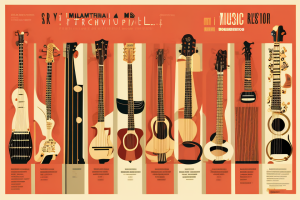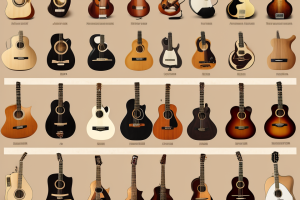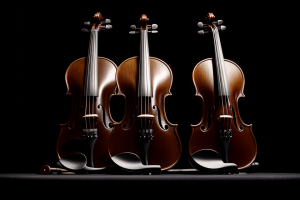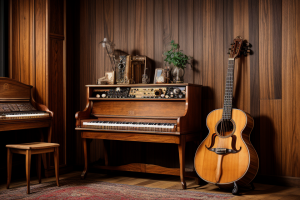
When did the first musical instruments emerge in human history? This is a question that has puzzled music enthusiasts and historians alike for centuries. From the ancient civilizations of Egypt, Greece, and Rome to the medieval ages of Europe, the development of musical instruments has been a continuous evolution of sound and artistry. Join us as we delve into the rich tapestry of musical history and uncover the origins of some of the world’s most beloved instruments. Get ready to be captivated by the story of how music came to life and how it has continued to shape our world to this day.
Musical instruments have been a part of human history for thousands of years. The earliest known musical instruments date back to the Paleolithic era, around 40,000 years ago. These instruments were simple, such as bone flutes and drums, and were likely used in rituals and ceremonies. Over time, musical instruments became more complex and diverse, with different cultures developing their own unique instruments. For example, the ancient Egyptians had instruments like the sistrum, a rattle-like instrument played during religious ceremonies, while the Greeks had the aulos, a woodwind instrument similar to the modern-day clarinet. Today, there are countless types of musical instruments, from pianos and violins to electric guitars and synthesizers, each with its own distinct sound and style.
The Evolution of Musical Instruments
The Earliest Instruments
Bone Flutes
Bone flutes are some of the earliest musical instruments that have been discovered by archaeologists. These flutes were made from the hollow bones of birds and were found in the archaeological sites of France, Germany, and China. The bone flutes date back to around 40,000 years ago, making them one of the oldest known musical instruments. They were likely used in rituals and ceremonies by early humans.
Drums
Drums are another ancient musical instrument that have been found in various archaeological sites around the world. The oldest known drum dates back to around 5,000 years ago and was discovered in the Egyptian city of Egypt. Drums were also used in religious ceremonies and were believed to have spiritual powers.
Rattles
Rattles are simple musical instruments that have been used by humans for thousands of years. They are typically made from hollow objects such as gourds or shells that are filled with small stones or beads. Rattles were used by early humans for a variety of purposes, including as a signaling device, a toy, and a musical instrument. They were often used in rituals and ceremonies, and were believed to have spiritual powers.
Overall, these early musical instruments were likely used by early humans for a variety of purposes, including for entertainment, communication, and spiritual expression. They represent some of the earliest examples of human creativity and innovation, and continue to be an important part of many cultures around the world today.
The Development of Stringed Instruments
The Lyre
The lyre is considered one of the oldest stringed instruments in history, dating back to ancient civilizations such as Greece and Egypt. It consists of a soundbox, two arms, and a crossbar, with strings stretched between the crossbar and the soundbox. The strings are plucked or strummed with the fingers or a plectrum to produce music. The lyre was popular in ancient Greece, where it was used in religious ceremonies and as a form of entertainment. It was also a symbol of power and prestige, and was often depicted in art and literature.
The Harp
The harp is another ancient stringed instrument that has been around for thousands of years. It is a large, complex instrument with a triangular shape and a frame covered in strings. The strings are plucked with the fingers to produce music, and the sound is amplified by the resonating body of the instrument. The harp has been used in various cultures throughout history, including ancient Egypt, Greece, and Asia. It was also popular in medieval Europe, where it was played in courts and churches.
The Lute
The lute is a stringed instrument that originated in the Middle East and was later adopted by European musicians. It has a pear-shaped body and a neck with a fretted fingerboard. The strings are plucked or strummed with the fingers or a plectrum to produce music. The lute was popular in Europe during the Renaissance period, and was used in court and chamber music. It was also a popular instrument among traveling musicians and street performers.
Overall, the development of stringed instruments has played a significant role in the evolution of music throughout history. From the ancient lyre to the modern electric guitar, stringed instruments have been used to create a wide range of musical styles and genres, and continue to be an important part of musical culture today.
The Invention of Keyboard Instruments
The Organ
The organ is considered to be one of the oldest keyboard instruments. Its invention is attributed to the ancient Greeks, who built a hydraulic instrument called the “hydraulis.” This instrument used a system of pipes and air to produce sound. The hydraulis was later improved upon by the Romans, who added a pedal system to control the pipes.
The Piano
The piano is a relatively modern keyboard instrument, invented in the early 18th century by Bartolomeo Cristofori. Cristofori was an Italian instrument maker who sought to create an instrument that could produce a wide range of dynamics, from soft to loud. He achieved this by placing strings of different lengths inside the instrument, which could be struck by hammers connected to the keys. The result was a new type of keyboard instrument that quickly gained popularity among composers and musicians.
Over the centuries, the piano has undergone many changes and improvements, including the addition of more keys, the development of the pedal system, and the use of different types of wood and materials for the body of the instrument. Today, the piano remains one of the most popular and beloved keyboard instruments in the world.
The Impact of Musical Instruments on Society
The Role of Music in Ancient Civilizations
Mesopotamia
In Mesopotamia, music played a significant role in religious ceremonies and cultural celebrations. The oldest known musical instrument from this region is a set of bone flutes, dating back to around 30,000 BC. These flutes were found in the cave of Bacho Kiro, located in the present-day Bulgarian-Turkish border.
Egypt
Ancient Egyptians also valued music highly, as it was an essential part of their religious and cultural practices. Musical instruments, such as harps, lyres, and rattles, were depicted in ancient Egyptian artwork and were often used in ceremonies honoring the gods. The earliest known Egyptian musical instrument is a wooden flute, which dates back to around 2500 BC.
Greece
In ancient Greece, music was an integral part of everyday life, and musical instruments were widely used in both religious and secular contexts. The ancient Greeks invented several musical instruments, including the lyre, which was a stringed instrument that was played with a plectrum. The lyre was used in religious ceremonies and was also a popular instrument for entertainment. The ancient Greeks also used instruments such as the aulos, which was a reed instrument similar to the modern-day clarinet, and the crotala, which was a set of castanets used in dance music.
Overall, the role of music in ancient civilizations was significant, as it played a crucial part in religious and cultural practices. Musical instruments were an essential aspect of society, and their invention and development marked an important milestone in human history.
The Spread of Musical Instruments Across the Globe
The Silk Road
The Silk Road was a network of trade routes that connected China, India, Persia, Arabia, and the Mediterranean world. This route played a crucial role in the exchange of goods, ideas, and culture between the East and West. Along with spices, silk, and precious metals, musical instruments also traveled along the Silk Road. Musical instruments such as the lute, oud, and rebab were traded and adopted by different cultures, influencing the development of local music traditions. For example, the lute was introduced to Europe via the Silk Road, and it became a popular instrument in medieval and Renaissance music.
The Columbian Exchange
The Columbian Exchange refers to the exchange of goods, animals, and ideas between the New and Old Worlds after the arrival of Christopher Columbus in the Americas. This exchange had a significant impact on the musical instruments and music traditions of both the Americas and Europe.
Musical instruments such as the guitar, violin, and piano were introduced to the Americas from Europe, and they were adapted and transformed by local musicians. For example, the Mexican guitar is a fusion of the European guitar and traditional Mexican instruments, and it has become an essential instrument in Mexican music.
In addition, musical instruments such as the tom-tom, maracas, and flute were introduced to Europe from the Americas, and they influenced the development of European music. For example, the tom-tom became an essential part of the rhythm section in jazz and popular music, and the flute was adopted by European classical music traditions.
The Columbian Exchange also led to the spread of music genres such as jazz, salsa, and reggae, which have become global music phenomena. These genres are a fusion of African, European, and American musical traditions, and they demonstrate the cultural exchange that occurred as a result of the Columbian Exchange.
Overall, the spread of musical instruments and music traditions across the globe has played a crucial role in the development of music as a global language and cultural expression.
The Influence of Musical Instruments on Modern Music
Jazz
Jazz music is a genre that emerged in the late 19th and early 20th centuries in the African-American communities of the Southern United States. It is characterized by its improvisational nature, syncopated rhythms, and use of brass and woodwind instruments. The trumpet, saxophone, and piano are among the most commonly used instruments in jazz music. Jazz has had a significant impact on modern music, influencing genres such as rock, funk, and hip-hop.
Rock and Roll
Rock and roll is a genre of popular music that originated in the United States in the 1950s. It combines elements of blues, jazz, and country music, and is typically played on electric instruments such as the guitar, bass, and drums. Rock and roll has had a profound influence on modern music, inspiring countless subgenres and styles such as punk, heavy metal, and alternative rock.
Electronic Music
Electronic music is a genre that emerged in the mid-20th century with the invention of electronic instruments such as the synthesizer and the drum machine. It is characterized by its use of electronic sounds and digital technology, and encompasses a wide range of styles such as techno, house, and ambient. Electronic music has had a significant impact on modern music, influencing genres such as hip-hop, pop, and rock, and paving the way for new technologies and production techniques in the music industry.
FAQs
1. What is the earliest known musical instrument?
The earliest known musical instrument is the Neanderthal flute, which was discovered in the cave of the same name in Germany. The flute is believed to be around 40,000 years old and is made from the bone of a bird.
2. When did people start playing musical instruments?
It is difficult to say exactly when people started playing musical instruments, as there is no written record of the earliest musical instruments. However, it is believed that humans have been playing musical instruments for at least 40,000 years, as evidenced by the discovery of the Neanderthal flute.
3. What was the first musical instrument invented?
The exact origin of the first musical instrument is unknown, but one of the earliest known instruments is the lute, which was developed in ancient Mesopotamia over 5,000 years ago. The lute is a stringed instrument that is similar to a guitar and was popular in Europe during the Middle Ages.
4. What is the most popular musical instrument in the world?
The most popular musical instrument in the world is the guitar. It is used in a wide variety of musical genres, including rock, pop, country, and jazz, and is played by millions of people around the world.
5. What was the first electronic musical instrument?
The first electronic musical instrument was the Theremin, which was invented in the 1920s by Russian inventor Leon Theremin. The Theremin is an early electronic instrument that is played without any physical contact, using the player’s hands to control the pitch and volume.
6. When did people start writing music?
The earliest known written music dates back to ancient Egypt, where musical notation was used to record music for religious ceremonies over 4,000 years ago. However, it is believed that people have been creating and performing music for much longer than that, and that the earliest musical traditions were likely passed down orally from generation to generation.
7. What was the first music-making software?
The first music-making software was Musical Instrument Digital Interface (MIDI), which was developed in the 1980s. MIDI allows users to create and record music using a computer, and has revolutionized the way that music is created and produced.
8. What is the oldest surviving musical instrument?
The oldest surviving musical instrument is the harp, which has been around for over 5,000 years. The first harps were simple instruments made from wood and gut strings, and were used in ancient civilizations such as Egypt and Greece.
9. What is the difference between a musical instrument and a musical device?
A musical instrument is a device that is designed to produce sound in response to the player’s input, such as a guitar or piano. A musical device, on the other hand, is a device that is not designed specifically for music-making, but can be used to create music, such as a computer or smartphone.
10. What is the most important musical instrument in a particular genre?
The most important musical instrument in a particular genre can vary depending on the genre. For example, in classical music, the piano and violin are considered to be two of the most important instruments, while in jazz, the saxophone and trumpet are often featured prominently. In rock music, the guitar is considered to be one of the most important instruments, while in hip-hop, the microphone is essential for rapping and beat-making.







